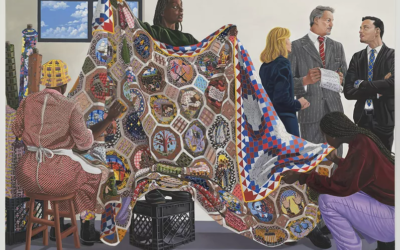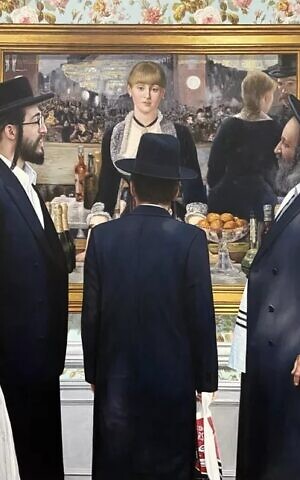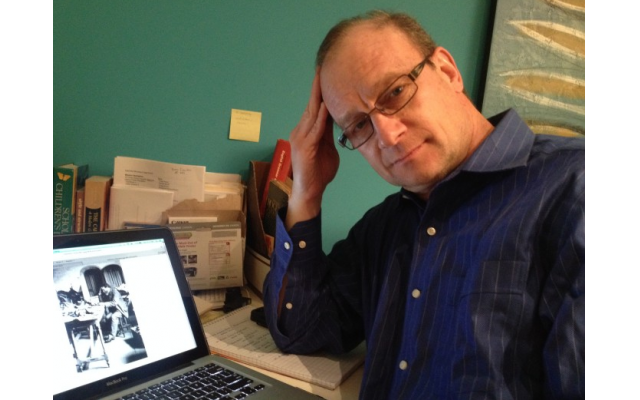Art in the Eye of the Beholder
Dave may be less than knowledgeable about art, but a few pieces caught his attention at an event in Chicago.
Dave Schechter is a veteran journalist whose career includes writing and producing reports from Israel and elsewhere in the Middle East.
There are subjects I know enough about to be conversant at a cocktail party and there are subjects I know enough about to keep silent.
Art, for example.
We recently toured Expo Chicago, an international exposition of contemporary and modern art that filled the 170,000-square-foot exhibition hall at Navy Pier. This was a trade show, where galleries from across the United States and two dozen other countries displayed works by their featured artists — at prices beyond affordability for the public that bought tickets just to browse the aisles.
A woman walking past me told her companion: “I know what I like, but I’m not educated.” I understand that sentiment. I like jazz, but not being a musician, the finer points of the music are lost on me. In Chicago, I saw much that was beyond my comprehension, some that I thought inventive and clever, and a few pieces that stuck in my mind.
I lusted after the glossy, multi-colored vertical lines of “ThereGoTheCloudsThereGoesTheSun,” created by German painter Markus Linnenbrink, using a technique called “drip painting.” Alas, we lack a wall large enough to properly show off a 5-foot-high and 10-foot-wide painting, never mind its $85,000 price tag.
My attention — and that of many others — was captured by “Bill of Sale,” a powerful work by 28-year-old Terron Cooper Sorrells.

The majority of the painting portrays three Black women working on a quilt depicting the African American experience. Its panels include ships that carried captives from Africa to slavery in America; the Civil War; jazz; the Ku Klux Klan; “Strange Fruit,” the song about lynchings made famous by Billie Holiday; marchers carrying signs reading “I Am A Man”; Barack Obama; and two arms raised, in a “don’t shoot” position.
Meanwhile, to one side, a woman and two men, wearing suits, are transacting business. One holds a paper reading “Bill of Sale for Art Work,” the imagined price no doubt far greater than what will be received by its creators.
Then there was “Three Jews Walk into a Bar” by Marc Dennis.
The website Artsy describes Dennis as “an American artist known for his hyper-realistic paintings of staged and slightly voyeuristic images of contemporary American culture, including individuals engaged in viewing iconic works of art.”

Here you see three Hasidic men standing before Edouard Manet’s painting, “A Bar at the Folies-Bergère,” while the barmaid looks out on them, as if awaiting their order.
My inclination was to chuckle at the incongruous images. Gallery staff let me know that Dennis is Jewish. According to a bio: “His father was born and raised in Havana, Cuba, in an orthodox Jewish family (often referred to as a ‘Jewban’), while ‘His mother was born and raised in the tough neighborhood of Roxbury, Massachusetts, in a reformed liberal Jewish family.’”
I sent a photo of “Three Jews Walk into a Bar” to a friend who writes about art and is an observant Jew. He was less amused and questioned whether the painting was a case of misappropriation and anti-Hasidic and wondered if the artist would treat Muslims or Buddhist monks similarly.
I raised these issues in an email to Dennis, whose varied works include Jewish themes. “First and foremost I am a Jew,” he replied, identifying himself as a kohen (a member of the priestly class, descended from the sons of Aaron).
Dennis added that two dozen fourth- and fifth-cousins died at Auschwitz-Birkenau during the mass deportation of Jews from Hungary in 1944 and that three more died as partisan fighters. He is co-producer of “Mirrors,” a multimedia art installation of interviews with survivors, and teaches a course at Elmira College entitled “Under the Floorboards — Hidden Art of the Holocaust.”
“My painting — ‘Three Jews Walk into a Bar’ — is anything but anti-Hasidic. It is loving. It is a deep dive into my ancestral Ashkenazi roots. It is a F*** You to Hitler. It is life,” Dennis wrote. “I’m not interested in painting Moslems or Buddhists; for that is not my experience. It is not my culture. It is not my history. It is not my bloodline.”
“Three Jews Walk into a Bar,” was “a wicked labor of love,” he said, using the New England slang definition of “wicked” as a superlative.
I remain hesitant to discuss art at a cocktail party, but Expo Chicago was an eyeful and left me with a better sense of what I like, even if I’m not educated.




comments